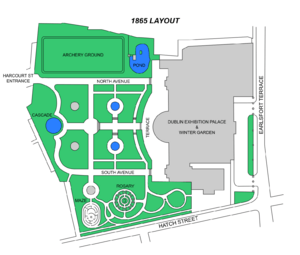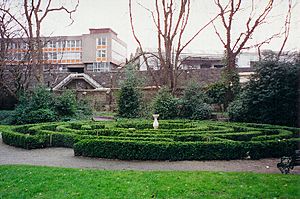Iveagh Gardens facts for kids
Quick facts for kids Iveagh Gardens |
|
|---|---|

Waterfall in Iveagh Gardens
|
|
| Lua error in Module:Location_map at line 420: attempt to index field 'wikibase' (a nil value). | |
| Type | Municipal |
| Location | Dublin |
| Area | 8.5 acres (3.44 ha) |
| Created | 1865 |
| Operated by | Office of Public Works |
| Open | all Year |
The Iveagh Gardens (pronounced EYE-vee) is a beautiful public park in Dublin, Ireland. It's located between Clonmel Street and Upper Hatch Street, close to the National Concert Hall. Unlike many other parks in Dublin, the Iveagh Gardens are almost completely surrounded by buildings. This makes them a bit hidden and a special secret garden! It's considered a National Historic Property, meaning it's very important to Ireland's history.
Contents
History of the Gardens
The land where the Iveagh Gardens now stand was once known as Leeson's Fields in 1756. It was named after Joseph Leeson, who was the 1st Earl of Milltown.
From Private Gardens to Public Park
In the late 1700s, Lord Milltown leased the land to John Hatch. He was a big builder in Dublin. Hatch then sold the land to the 1st Earl of Clonmell. The Earl used it as his own private gardens, and they became known as "Clonmell Lawns."
The Earl even had a secret underground passage. It connected his house on Harcourt Street to his gardens. This meant he didn't have to walk across the street to get to his beautiful green space!
When the 1st Earl of Clonmell passed away in 1798, his son inherited the gardens. In 1810, the estate was sold. Around 1817, the gardens were opened to the public. They were renamed "Coburg Gardens" after the royal family of Saxe-Coburg.
By 1860, the gardens were not well cared for. They were used for grazing sheep and even for dumping waste.
The Dublin Exhibition Palace
In 1862, a man named Sir Benjamin Lee Guinness helped start a company. Its goal was to create a place for Irish arts and crafts. It would also have reading rooms, flower gardens, and a special winter garden. This was inspired by the famous Crystal Palace in London.
Sir Benjamin sold the 17-acre site to this company for the same price he had paid for it. The Dublin Exhibition Palace and Winter Garden officially opened on May 9, 1865. The Prince of Wales himself opened it!
The Guinness Family's Gift
In 1870, Sir Benjamin Lee Guinness's sons, Edward Cecil Guinness and Arthur Edward Guinness, bought the buildings and grounds back. The Winter Gardens part was later sold in 1882 and moved to England.
In 1883, Edward Cecil Guinness sold the exhibition buildings. They were turned into the new Royal University. However, the gardens stayed with the Guinness family.
Years later, in 1937, Éamon de Valera (who was Ireland's leader, the Taoiseach) asked the 2nd Earl of Iveagh if he would sell the gardens to the Irish state. At first, the Earl said no.
But on May 4, 1939, Lord Iveagh wrote to Éamon de Valera. He offered the Iveagh complex as a gift to the nation! Lord Iveagh wanted to make sure the gardens would always be "unbuilt on." He called them a "lung" for Dublin, meaning a green space for the city to breathe. The Irish Government happily accepted this wonderful gift on May 17, 1939.
Managed by the Office of Public Works
In 1991, the gardens were put under the care of The Office of Public Works (OPW). The OPW's job was to:
- Protect and fix this special city park. It had stayed mostly the same since it was designed by Ninian Niven.
- Make it easier for people to visit by adding a new entrance.
- Showcase the work of Ninian Niven, a famous landscape designer.
- Keep the plants and trees healthy to block out nearby buildings.
- Highlight all the different parts of the garden for everyone to enjoy.
- Restore the gardens to their original look, making them a unique place to visit in Dublin.
A big project to restore the gardens began in 1992. They were reopened to the public that same year. The beautiful waterfall was also fixed up in 1996. In 2003, a new entrance was added from Upper Hatch Street, making it even easier to find this hidden gem!
Design of the Gardens
The Iveagh Gardens were designed by Ninian Niven in 1865. His design mixes two different styles: the very neat 'French Formal' style and the more natural 'English Landscape' style.
Cool Features to Explore
- Archery Field: Near the Earlsfort Terrace entrance, there's a large sunken lawn. This is one of only two places in Ireland specifically built for archery! Long ago, there was a pond and a boating tower here.
- The Cascade: This amazing waterfall flows over a huge rockery. The rocks used to build it came from all 32 counties of Ireland! Today, the waterfall uses recycled water. But originally, it got its water from the Grand Canal.
- The Maze: The gardens also have a fun maze! It's a smaller copy of the famous Hampton Court Maze in London.




